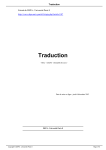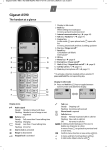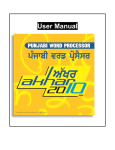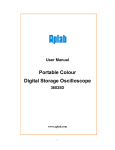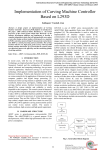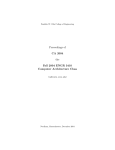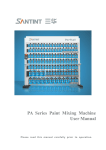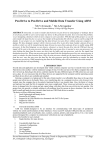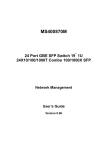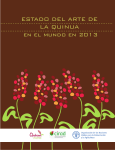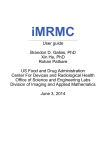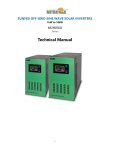Download Welcome to My Marathi!
Transcript
Welcome to My Marathi! As a first generation Marathi growing up outside of India, I found myself at a point in my life where I wanted to improve my ability to understand, speak and write Marathi. But I could not find a product in the market that presented Marathi language structure in an interactive format where you could hear the language and learn at your own pace. So I decided to build one. Now, I don’t claim to be a Marathi scholar (or a software programmer), but I believe that My Marathi is a conscientiously built compilation of Marathi learning materials adapted for the next generation of Marathis growing up outside of India. My quest to create My Marathi stems from a wish to help bridge the past, present and future of our community. Looking towards our future, My Marathi is dedicated my bright and beautiful nieces M&J. My Marathi is also dedicated to those members of our global Marathi community 1 that are no longer with us. Particularly Mangala Deodhar, Vrushali Ranadive, Arati Sharangpani, and so many others that we did not get the chance to spend enough time with. Last but certainly not least, My Marathi is dedicated to our Ajis and Ajobas. They have seen so many decades of change and have supported their children and grandchildren in the choices they have made. They quietly stressed how important it is to practice Marathi, and at some point in all of our lives we will think about how much that really means. So, you are taking a big proactive step here by purchasing My Marathi! Remember that you didn’t learn English in a couple of weeks- it will take time and practice to really feel confident with Marathi. Also remember that you are not alone. There are many others learning with you! See the My Marathi website for more information on where proceeds will be donated, supplemental tutoring, or My Marathi news: http://mysite.verizon.net/vze1xqrx/mymarathi www.MyMarathiLearning.com TABLE OF CONTENTS My Marathi Overview p. 4 Getting Started - the HELP Screen p. 5 My Marathi – Logo and Meaning p. 7 My Marathi Layout of Major Modules Culture Module Grammar Module Conversations Module Vocabulary Module p. p. p. p. Phonetic cheat sheet p. 23 Some General Notes about Marathi and My Marathi p. 25 Credits p. 29 Index p. 31 I look forward to chatting with you in Marathi one day soon! Hemangi Joshi-Deodhar 2 3 8 9 12 18 MY MARATHI OVERVIEW GETTING STARTED – The HELP screen The My Marathi learning tool consists of four major modules over two CDs: System Requirements: You need to be running Windows 2000 or higher. If you are not, you may not be able to use all modules of My Marathi. CD1: Grammar, Conversations, Culture CD2: Vocabulary When you insert either CD into your computer, My Marathi should launch automatically. The modules are launched from the drop down menu along the top of the screen. Installation Steps: When you start CD1 go to the HELP Screen for first time users. This page gives steps on installing the software needed to run all of the modules of My Marathi: My Marathi contains over 12,000 recordings to illustrate pronunciation of Marathi words, phrases and conversations. a. Phonetic translations are given everywhere so that you can read the Marathi words even if you don’t learn the Marathi written characters. b. Click this icon for the Home Menu for access to these screens: • About- My Marathi overview • Help- Getting Started information and installation links • Abbreviations Key • Other useful Marathi Links 4 c. You will need Adobe Acrobat to be able to view and print pdf versions of Grammar Lessons. Link and test file given on CD1 Help screen The Vocabulary and Conversations Modules need Microsoft Access 2003. If you don’t have Access 2003, a Runtime version is included and can be installed through a link on the Help Screen. Installing Marathi Font. Some computers automatically will install the font needed to view Marathi text on the CDs. The Help screen will give you a test screen and instructions to follow if you need to manually install the font. 5 d. Quick Time is one of the pieces of software used to play sound bytes. When you launch CD1, a Quick Time installation screen will automatically come up if you don’t have Quick Time. You can run the My Marathi software right off of each CD. If you want to run the software from your hard drive, just copy each full CD to a specific location. The content of either CD can be started by clicking on the corresponding Launch.exe file. The content of the two CDs would still be separate, but you can have them open as separate windows at the same time. MY MARATHI LOGO AND MEANING The symbol of a lotus was chosen to be the center point of the My Marathi logo because knowledge is one of the key themes that the lotus symbolizes. The title My Marathi was selected for this learning tool for the dual meanings it represents: In Marathi, “mAy marAThee” means mother tongue. Click on icons like these throughout the CDs: To go back to the previous screen The English meaning of “My Marathi” was chosen with the hopes that you will feel that Marathi is yours to use and pass on. To advance to the next screen To display help text / hints 6 7 CULTURE MODULE GRAMMAR MODULE The Culture Module gives some general explanations of miscellaneous cultural aspects: • The Marathi Language • Hindu Calendar, Religion, and Holidays • Hindu Sanskars • Hindu Mythology • Miscellaneous Cultural Traditions • Maharashtra History/ Indian Independence/ Indian National Anthem (including translation and recording) The Grammar Module is on CD1 and covers the basics of Beginner Marathi Grammar. The GRAMMAR drop down menu at the top of the screen will allow you to navigate through the different lessons. The material presented in the cultural section of My Marathi may seem heavy on Hindu cultural items; but since the vast majority of Maharashtrians are Hindu, Hindu culture was given more focus than other religious traditions in My Marathi’s Culture Module. (Recorded Hindu prayers and Aratis can be found in the Conversations Module.) Note that all of the descriptions of cultural traditions given in the Cultural Module of My Marathi are brief and are meant only to give a very general understanding of each cultural topic. To explore any of these topics in greater detail, search the web or visit your local library. 8 Click on icons like these to view (or print) full detailed versions of any grammar lesson with additional explanations, exceptions and practice exercises. The pdf versions are opened using Adobe Acrobat Reader. A basic outline of the Grammar Lessons: Lesson 1: The Marathi Alphabet (vowels and consonants), Pronunciation Hints Lesson 2: Barakhadi – joining vowels with consonants Lesson 3: Conjunct consonants – joining consonants Lesson 4: Nouns – Marathi nouns are classified by gender (masculine, feminine, neuter). Basic 9 rules are illustrated, then additional exceptions are covered in pdf version. Lesson 5: Adjectives- classified as variable and invariable Lesson 14: Sentence Conjunctions – combining sentences Lesson 15: General Word Order in Marathi Sentences Lesson 6: Pronouns – basic pronoun forms are illustrated. Additional forms detailed in pdf version. Appendix: Morphophonemic Rules Lesson 7: Interrogatives (forming questions) Verb Cheat Sheet – to help summarize verb uses described in Lessons 8-11, & 13 grouped by verb type. Lesson 8: Verb classification (Transitive/Intransitive, Personal/Impersonal, Tense/Aspect) Rationale- notes about some of the decisions made regarding presentation of material in the Grammar Module. Lesson 9: The Auxiliary verb asaNe (to be) Lesson 10: Simple Sentences- This is a large lesson outlining the use of verbs in different forms of sentences. (Particularly section 10grouped by tense/aspect.) Lesson 11: Verb Forms and Irregular Verbs Lesson 12: Adverbs, Postpositions, Particles Lesson 13: Verb Operators 10 11 CONVERSATIONS MODULE Immerse yourself in hearing and reading Marathi with the Conversations Module. The Conversations Module is a MS Access database that is launched from CD1. You can also launch the Conversations Module directly by opening the Access Database titled: Conversations.mdb located in the Bin Folder. You will have the choice to view: • Conversations • Unit Summaries • Specific Conversations (including Hindu prayers and aratis). CONVERSATIONS: There are 51 sets of conversations presented. Each conversation contains several dialogues with recordings, notes on new information, and questions for practice. Choose a conversation # from the dropdown menu and click on this icon above it to launch that conversation. 12 Hint: • If you review the dialogues and notes within a conversation and can respond to the questions for practice, you can feel comfortable moving on to the next conversation. UNIT SUMMARIES: The 51 conversation sets are grouped in Units to focus on various Grammar topics. For example, Unit 1 Summary (U1) reviews Conversations 1 through 4. So, once you have reviewed conversations 1-4, you can select Unit 1 Summary (U1) and click on the binoculars icon to read (or print) the key topics covered. Unit topics are outlined on pages 15-17. SPECIFIC CONVERSATIONS: Specific Conversations were recorded on the following topics: • mhaNee (idioms) • Talking with Aji, Hello how are you, and more... • Food, Mealtime... • Health... 13 • Telling Time • Prayers and Aratees: o Puja for Ganapati (shree gajAnan prasanna) o Morning Prayers (prAtahsmaraN) o Evening Prayer (sAyankALachee prArthanA) o Before Dinner Prayer (jewaNApUrchee mhaNAwayAtse shlok) o 1st Arati – for Ganapati (Aratee shreeganapateechee) o 2nd Arati - for Ganesh’s Mother (Aratee shrideveechee) o 3rd Arati – for Shiva (Aratee shreeshankarAchee) o 4th Arati for Guru Datta (Aratee shreedattAtreyAchee) o 5th Arati for Vittal (Aratee shreewiThThalAchee) o General prayer that is also sung at end of aratis (prArthanA) o Vedic prayer (mantrapushhpAnjali) Choose the specific conversation you want from the Specific Conversations dropdown menu and click on this icon above it to launch. 14 Outline of Conversations Units (& lesson #s): Unit 1 1-4 Noun gender, variable adjectives Unit 2 5-6 Imperatives. Imperfect and Present Continuous Unit 3 7-8 Oblique Forms of Masculine and Neuter Nouns Unit 4 9-10 Masculine Plural Forms of Nouns and Adjectives Unit 5 11-12 Neuter plural forms of nouns and adjectives, Adjective Oblique Forms: -AyatsA form of verbs, Perfect Forms Unit 6 13-14 Feminine plural forms of nouns and adjectives Unit 7 15-16 Agent suffix –nee, Perfect endings of transitive verbs Unit 8 17 Unit 9 18-19 Perfect Forms without agreement, Formal plural Agent forms, Perfect of transitive & spec. trans. verbs 15 20-21 Feminine Obliques, Possessive Plural, The pronouns dzo, jee, dze, Present negative past and continuous Unit 20 40-41 Adjectives based on a noun plus –t, Superlatives Unit 21 42-43 N-lA impersonal verbs Unit 11 22-23 Noun forms ending in –lA, Future Forms Unit 22 44-45 Verb + paryanta, Time expressions Unit 12 24-25 Future forms, Oblique & plural of fem. nouns ending in -A Unit 23 46-47 Suffixes –tAnA, -lelA, Shortened forms of relative sentences Unit 13 26-27 -NarA ending. Masculine nouns ending in –ee. Unit 24 48-49 The suffix –Un, Indirect speech Unit 25 50-51 Perfect forms with postpositions, the suffix -Un Unit 10 Unit 14 28-29 Expressions with kar- and ho- Unit 15 30-31 The pronoun dzo Unit 16 32-33 Translations of “if” Unit 17 34-35 The subjunctive form Unit 18 36-37 Negative subjunctive, -AyalA form, Plural of neuter nouns ending in –a. Unit 19 38-39 -AwA plus lAgaNe, Infinitive form, Contrary to fact condition 16 You can hide or view the phonetics if you are trying to practice reading the Marathi script or hide or view the English translations if you choose. Use of the Conversations Module can be parallel to use of the Grammar Module. Note that there could be slight differences between nomenclature details in the Grammar Lessons and Conversation Unit summary lessons as they were based on different sets of texts. 17 VOCABULARY MODULE The Vocabulary Module is launched off of CD2. The Vocabulary Module is a searchable database of over 9,000 recording of Marathi words, some phrases, and numbers. When you open the Vocabulary database you will see a screen that looks like this: mango pulp and run the search by clicking on the binoculars icon below, the database will not look for the two words separately; it will look for exactly what you enter, including the space. • You can also search by the phonetic pronunciation of the Marathi word you are looking for. You can search for words/phrases that start with certain letters, contain a certain letters, and/or end with certain letters. • You can also search by part of speech. If you know the word you are looking for is a noun, you can narrow down your search by selecting noun from the dropdown menu. Vocabulary Module Modified Search Options found on the right side of the screen help you narrow down your search results. REGULAR SEARCH OPTIONS Note- searches are not case sensitive, but the database will be looking for an exact match with what you enter. • You can search by words contained in the English definition of a word. For example, if you type in: 18 • Narrowed Down Definition search may help narrow down a definition search. For example, if you search for the definition "mother" and click the binoculars icon on the bottom left, you will also get results including “grandmother”. If you run using the modified search option for 19 definitions, grandmother would be filtered out. (See also Examples section) • The modified part of speech dropdown will give you more specific part of speech choices. Running this modified search will filter results on the English Definition and phonetic filters you enter on the left, and the specific part of speech you choose on the right side. For example, if you choose “verb” as the part of speech to search for on the left side, but choose “feminine noun” on the right side, if you launch the search from the launch button on the right side- the database will search for feminine nouns. (Launching the search with the binoculars button on the bottom left will search for verbs.) If you have anything filled into the Definition or Phonetic fields, those will also be filtered into the search. Try playing with different scenarios to get used to the different search functions available to you. Examples: If you enter the word “aunt” into the English definition search field (like on the previously shown screen) and press the run search icon at the left bottom of the screen, your search results will include all words in the vocabulary database that 20 contain the word “aunt” (which will also include “taunt”)- there are 8 results in total so you would need to scroll down to see all of the results. Narrow down the search by running the same English Definition filter of “aunt” but running the search by clicking the binoculars icon on the top right next to “Run Narrowed Down Definition Search.” (This essentially searches for the exact word/phrase you have entered, but with a space beforehand.) This way you get these 5 results: 21 PHONETIC CHEAT SHEET A phonetic convention has been created for My Marathi so that even if learning to read the Marathi script is not your first priority, you will always be able to read phonetic translations and follow along with the pronunciations presented. This phonetic convention is case sensitive and is kept consistent throughout the CDs. Learning the phonetic spelling convention used in My Marathi for the different vowels and consonants will help you follow all of the pronunciations faster. Be sure to scroll down through all of the choices to find the meaning or type of word that you are looking for. Note that the phonetically spelled pronunciation of the words/phrases you find are case sensitive. A lower case letter will indicate a different Marathi sound than a capital letter, or combination of letters. Grammar Module Lesson 1 steps through all of the basis Marathi sounds that make up Marathi words and gives audio pronunciations. Grammar Module Lesson 1 presents the Marathi alphabet in greater detail with sound bytes and tips for pronunciation. Below is a summary: Vowels: Explanations of different parts of speech are found in the Grammar Module. 22 23 Consonants: Some General Notes about Marathi and My Marathi 1. No matter how hard I tried to have material in these CDs proofread and corrected, no publication is ever perfect and there is always the chance that there are errors. Please excuse any errors that you find and understand the grass roots nature of this project in general. That said, if you find errors please let me know about them in case they can be corrected if there is another printing of My Marathi. 2. A phonetic English convention has been created for My Marathi so that even if learning to read the Marathi script is not your first priority, you will always be able to read English translations and follow along with the material presented. This phonetic convention is case sensitive and is kept consistent throughout the CDs. See pages 23-24 for a “cheat sheet” for the phonetic spelling convention consistently used throughout My Marathi. 3. Sounds made in Marathi are built with different lip and tongue positions and originate from different parts of the mouth and throat than many English sounds. 24 25 Therefore, some Marathi sounds may seem difficult until you get used to hearing the differentiation between them. For example, there are many more vowel sounds in Marathi than in English. There are also four different “T” related sounds, and four different “D” related sounds. Phonetically, they will be represented with combinations of lower case versus upper case letters. So, t th T Th t 4 3 # as in tawA (griddle, pan) as in thaNDee (cold) as in Takkal (bald head) as in ThasakA (sudden cough) Grammar Module Lesson 1 presents a lot of detail and recorded pronunciations to help you get used to pronunciation of different letters of the Marathi alphabet. 4. Marathi words and phrases often get shortened in colloquial speak. For example, if you want to say, “I am here”, you would say… “mee ithe Ahe.” (mI [4e Aahe|) If you heard a native Marathi speaker say the same sentence, it may sound more like “mee ithe A-e.” (with the h in Ahe softened). 26 All of the words you will see are written out in Marathi and phonetic English are written out properly as if you were going to speak slowly and clearly. (Also see next note.) 5. Depending on the situation, Marathi conversation can be very formal or very informal. In general, both familiar and respectful language are detailed in the CDs. In some cases, the written form of Marathi is different than the generally spoken form. In these cases, the more practical generally spoken form is presented. Footnotes are given to explain when these differences occur. 6. Note that there each consonant pronounced by itself as a syllable, is pronounced with an inherent “a” sound following the consonant sound. The inherent “a” at the end of the word is commonly cut off, making the spoken word sound one syllable shorter. More explanation is found in Grammar Module Lesson 1 (see pdf of full lesson). 7. Full Marathi words are written out in Devanagri script phonetically, so there are no silent letters. If you learn to read Marathi words, you will know exactly how there are supposed to be 27 pronounced. (Unlike in English where you need to learn where similar spellings may be pronounced differently, like four versus flour.) 8. To hear which syllable of a word should get emphasized in speech, utilize the sound bytes available throughout the CDs. Play sound bytes by clicking buttons like these: in the Grammar Module and Cultural Modules in the Vocabulary and Conversation Database Modules CREDITS The Grammar lessons in this CD are based on the lessons in Maxine Berntsen and Jai Nimbkar’s text titled “A Marathi Reference Grammar.” The Vocabulary Module is based on “A Basic MarathiEnglish Dictionary” by the same authors. Thanks to the University of Pennsylvania South Asia Studies Department for granting me permission to use these materials to build My Marathi. A complete set of texts continuing through Intermediate and Advanced Levels is available through U. Penn’s SAS Dept. Some lesson notes are taken directly from these texts. Refer to these texts for more in depth information. The Conversations Module is based on the research of Franklin C. Southworth and Naresh B. Kavadi in their text “Spoken Marathi.” This copyrighted material was used in My Marathi with permission granted by the Univ. of Penn. Press. Philadelphia PA. No part of this work may be reproduced or transmitted in any form or by any means, electronic or mechanical, including photocopying, or by any information storage and retrieval system, without permission in writing from the University of Pennsylvania Press. Thanks to Vijay Pathare for help with editing Grammar lessons, Anand H. Joshi for help in editing 28 29 vocabulary dictionary content, Dr. Suneeta Vaze for her efforts in proofreading data in the Vocabulary and Conversations databases and prayer translations, Anjali Vaze for her help in building the Culture Module, Tony Greco for his help with package design, Y V Sathaye for the use of his Marathi Kanak font. Additional thanks to Mohan Ranade, Shubangi Joshi, Rebecca Karamehmedovic, Sai Samant, Govind Modi, Sandeep Pathak and everyone who helped with product testing, technical advice and overall moral support! Special thanks to my family for believing in me – particularly to my Dad for being my loudest cheerleader. Love always to Mandar for supporting my hiatus from the paycheck earning world to work on this project that was so important to me to complete! Thanks to Leena Shitut for donating the first $20 to the project without me having to ask for it! Thanks also to the following generous people for donating at least $250: Sudhir & Sheila Kulkarni, Leena & Ravindra Shitut, & Sanjeevanee Joshi. Thanks of course to those who donated anything at all, because every dollar helped! For visit thethe MyMy Marathi website at For comments, comments,please please visit Marathi webpage www.MyMarathiLearning.com or email Hemangi at at http://mysite.verizon.net/vze1xqrx/mymarathi/ [email protected] or email Hemangi at [email protected] 30 INDEX abbreviations 4 about My Marathi 4 adjectives 10, 15 adverbs 10 alphabet 9, 23-24 aratis 8, 14 bArAkhadi (joining consonants & vowels) 9 cheat sheet 11 conjunct consonants 9 conjunctions 10 conversations (lessons, unit summaries, specific conversations) 12-17 credits 29-30 cultural traditions 8 gender of nouns/adjective endings 9, 10, 15, 16 getting help (CD Help, finding a mentor) 2, 5 getting started 5 grammar 9-11, 15-17 help screens 5 Hindu prayers, aratis 8, 13-14 Hindu Calendar 8 Hindu sanskars 8 Hindu mythology 8 Indian Independence 8 Indian National Anthem 8 inherent a sound for consonant sounds 27 interrogative forms (questions) 10 31 Maharashtra history 8 Marathi & My Marathi notes 25-28 Marathi links 4 morphophonemic rules 11 My Marathi CD1 4 My Marathi CD2 4 nouns, gender 9, 15, 16 pdf versions of grammar lessons 9 phonetic convention, cheat sheet 11, 23-24 prayers 8, 13-14 prepositions (called postpositions in Marathi) 10 pronouns 10 sentence construction 11 sound bytes 4, 5-6, 28 verbs (classification, cheat sheet) 10, 11 vocabulary search, interactive dictionary 18-22 word order in sentences 11 32 33


















